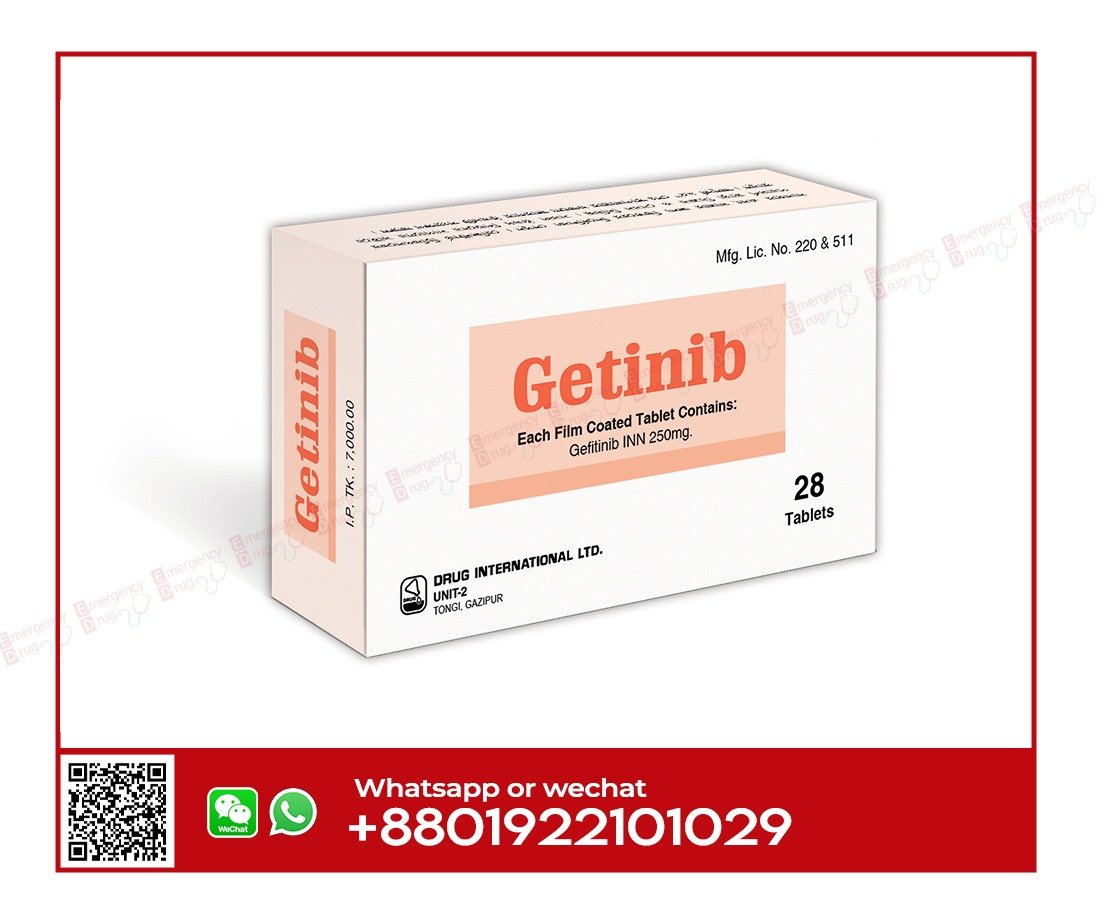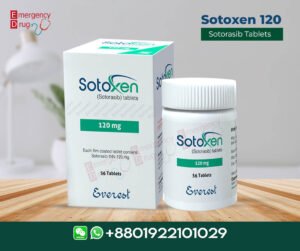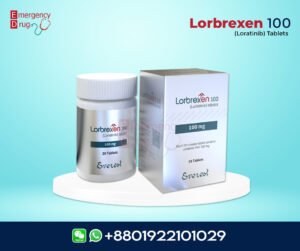Description
Getinib 250 mg Composition: Each film coated tablet contains Gefitinib INN 250 mg.
Product Features
| Product Name | : | Getinib |
| Generic Name | : | Gefitinib |
| Formulation | : | Tablet |
| Available Pack Size | : | 28’s Pot |
| Available Strength | : | 250 mg |
| Registrations | : | Export Only |
Tab Getinib 250 MG Price in Bangladesh: $100.00
How Does Getinib Work? (Mechanism of Action)
Getinib is a medication that stops certain types of EGFR (epidermal growth factor receptor) from working properly. This action prevents the receptor from activating itself and sending signals further down the cell, which would normally lead to cell growth.
Gefitinib works particularly well on EGFR with specific mutations, like exon 19 deletion or exon 21 point mutation L858R. It’s even better at binding to these mutated versions of EGFR compared to the normal, wild-type EGFR.
Additionally, at doses commonly used in treatment, gefitinib can also interfere with the signaling of other growth factors like IGF and PDGF. However, its effects on other types of receptors haven’t been fully studied yet.
Absorption and Distribution
Getinib has an oral bioavailability of 60%, meaning that when taken by mouth, about 60% of the medication reaches the bloodstream. Peak levels in the blood are typically reached between 3 to 7 hours after taking the dose. Interestingly, whether you take gefitinib with or without food doesn’t significantly change how much of the medication your body absorbs.
When Getinib is in the bloodstream, around 90% of it binds to certain proteins in human plasma, specifically serum albumin and α1-acid glycoprotein. This binding doesn’t depend on the concentration of the drug in the blood.
Metabolism and Elimination (Gefitinib Structure)
In humans, gefitinib is broken down extensively in the liver, mainly by an enzyme called CYP3A4. There are three main ways it gets metabolized: one involves changing the N-propoxymorpholino-group, another is demethylating the methoxy substituent on the quinazoline, and the third is oxidatively defluorination the halogenated phenyl group.
Scientists have identified five different metabolites of gefitinib in fecal samples. The most significant active component among these metabolites is O-desmethyl gefitinib, which is produced when CYP2D6 metabolizes it. This metabolite accounts for about 14% of the original dose.
After being given intravenously, gefitinib is primarily cleared by the liver. Its total plasma clearance and the time it takes for half of it to be eliminated from the body (elimination half-life) is about 48 hours. Steady levels of gefitinib in the blood are usually reached within 10 days of taking daily doses.
When the body gets rid of gefitinib and its metabolites, most of it (about 86%) is expelled through the feces. Only a small fraction (less than 4%) is eliminated through the urine.
Getinib Side Effects
Gefitinib tablet can cause several side effects, including:
- Interstitial Lung Disease
- Hepatotoxicity (liver damage)
- Gastrointestinal Perforation
- Severe or Persistent Diarrhea
- Ocular Disorders such as Keratitis
- Bullous and Exfoliative Skin Disorders
Dosage and Administration
The recommended dose of Gefitinib is 250 mg taken orally once daily, with or without food. Continue taking it until disease progression or if you experience intolerable side effects. If you miss a dose, do not take it within 12 hours of your next scheduled dose.
Administration for Patients who have Difficulty Swallowing Solid Tablets
If you have trouble swallowing tablets, immerse the Gefitinib tablet in 4 to 8 ounces of water for about 15 minutes. Stir the mixture and then drink it immediately, or administer it through a naso-gastric tube. Rinse the container with 4 to 8 ounces of water and drink it immediately or administer it through the naso-gastric tube.
Dose Modification
Hold off on taking Gefitinib 250 mg for up to 14 days if you experience any of the following:
- Sudden or worsening pulmonary symptoms like shortness of breath, cough, or fever.
- ALT and/or AST elevations of Grade 2 or higher according to NCI CTCAE.
- Diarrhea of Grade 3 or higher according to NCI CTCAE.
- Severe or worsening symptoms of ocular disorders, including keratitis.
- Skin reactions of Grade 3 or higher according to NCI CTCAE.
Resume treatment with Gefitinib once the adverse reactions fully resolve or improve to Grade 1 according to NCI CTCAE.
Discontinue Gefitinib (Getinib) permanently if you experience:
- Confirmed interstitial lung disease (ILD).
- Severe hepatic impairment.
- Gastrointestinal perforation.
- Persistent ulcerative keratitis.
Discontinue only under the direction of a registered physician.
Use in Pregnancy and Lactation
There haven’t been enough studies to determine the safety of Gefitinib (Getinib) in pregnant women. If a woman uses Gefitinib during pregnancy or becomes pregnant while on this medication, she should be informed about the potential risks to the fetus or the possibility of losing the pregnancy.
It’s unclear whether Getinib is passed into human breast milk. However, because Gefitinib drug can lead to serious adverse reactions in nursing infants, women should stop breastfeeding while undergoing treatment with Gefitinib 250 mg tablet.
Gefitinib 250 mg Uses
Pediatric Use: The safety and effectiveness of it in pediatric patients haven’t been established.
Renal Impairment: Clinical studies on Gefitinib didn’t include patients with severe renal impairment.
Hepatic Impairment: Adverse reactions should be closely monitored in patients with moderate to severe hepatic impairment who are taking Getinib.
It produces by Drug International Ltd., which is a Bangladeshi pharmaceuticals manufacturer company.
Note: Above information are taken from Gefitinib (Getinib) prescribing information.
Visit our other egrf mutation lung cancer medicine.








Reviews
There are no reviews yet.